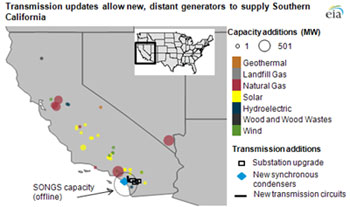Shut down since December 2012, California’s controversial San Onofre nuclear plant is now closed permanently, in another blow to the industry and a net positive for energy efficiency and renewable energy.
The plant, which had two reactors, is the largest nuclear facility to close in the US in the past 50 years. Situated on the Pacific coast, leaking radiation threatened the millions of people who live along the Los Angeles/ San Diego corridor.
A small radiation leak found in January 2012 led to the discovery of damage to hundreds of tubes that carry radioactive water. The brand new tubes were eroded so badly that they could fail and potentially release radiation. Southern California Edison spent more than $500 million to correct the situation in hopes of restarting one reactor this year, but it finally gave up in the face of strong opposition from regulators, lawmakers and the public.
Operating since 1968, the aging 2200 megawatt plant had the capacity to serve 1.4 million homes, about the same amount produced by solar on June 7, when it supplied over 5% of the day’s peak demand.
Although President Obama threatened a nuclear renaissance when he took office, the industry has faced the same problems it has in the past, especially after Japan’s blowout. In addition to disinterested investors, cheap natural gas has made nuclear less attractive.
"The decision to shut down San Onofre is another sign that the economics of nuclear are under pressure given the low cost of alternative sources," Travis Miller of Morningstar, told Bloomberg.
Nuclear provides 19% of US electricity, the lowest since 1998, according to the US Energy Information Administration (EIA). Its peak was in 2001 when it supplied 20.6% of electricity.
Will California Have Enough Electricity Without San Onofre?
Worries immediately emerged about California’s ability to meet peak demand this summer, but the California Independent System
Operator says it has it handled. Since San Onofre shut down they have bolstered the grid and on the hottest days, the state will call for energy conservation.
More natural gas has been used since the shut down, which thanks to cheap fracking, now supplies more than 60% of power in the state, up from 50% in 2000.
Although many say Southern California will have to import more energy and new natural gas-fired plants are coming online in-state, to make up the difference, a graph from EIA tells a different story.

The shutdown will cause the state to move faster toward relying on renewable energy.
The economic climate, coupled
with an increase in renewable energy sources like solar and wind generation, may
not bode well for new units, David
Lochbaum of Union of Concerned
Scientists, told Bloomberg.
"It’s difficult to get Wall Street to loan money against so much
uncertainty. The four closures this year make
Wall Street more apprehensive, not less apprehensive."
The decision to shut down rather than retrofit the San Onofre nuclear plant
shows the changing economics of the power market," Howard Learner of Environmental Law and Policy Center, told Bloomberg. "We suspect other nuclear plant
owners may start reaching the same decision."
Energy efficiency combined with renewable energy sources such as solar and wind are much faster to build, much cheaper, and certainly much safer than nuclear. Having enough water for them to operate is another problem.

